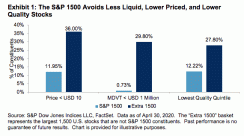Contributors
Phillip Brzenk, CFA, Senior Director, Strategy Indices
phillip.brzenk@spglobal.com
Hamish Preston, Associate Director, U.S. Equity Indices
hamish.preston@spglobal.com
Aye Soe, CFA, Managing Director, Global Head of Product Management
aye.soe@spglobal.com
EXECUTIVE SUMMARY
Launched in 1995, the S&P Composite 1500 (hereafter the “S&P 1500”) serves as a benchmark indicator for U.S. equity market performance, aggregating price movements of S&P 500®, S&P MidCap 400®, and S&P SmallCap 600® constituents to deduce common return drivers.
The S&P 1500 also increasingly serves as a basis for constructing portfolios designed to deliver a “market” return at lower cost than those active managers who offer to beat it. We shall examine the S&P 1500 from both perspectives, as well as examining its merits in comparison to popular alternatives. In particular, we observe that:
- The sizeable representation of U.S. companies means tracking U.S. equity market performance may be relevant to investors, globally;
- The S&P 1500 has outperformed the S&P 500, historically;
- Incorporating smaller companies in a U.S. market benchmark provides a more holistic view of the U.S. economy (see Exhibit 7); and
- Compared with other U.S. equity market indices, the S&P 1500 avoids relatively illiquid, lower priced, and lower quality stocks (see Exhibit 1).







